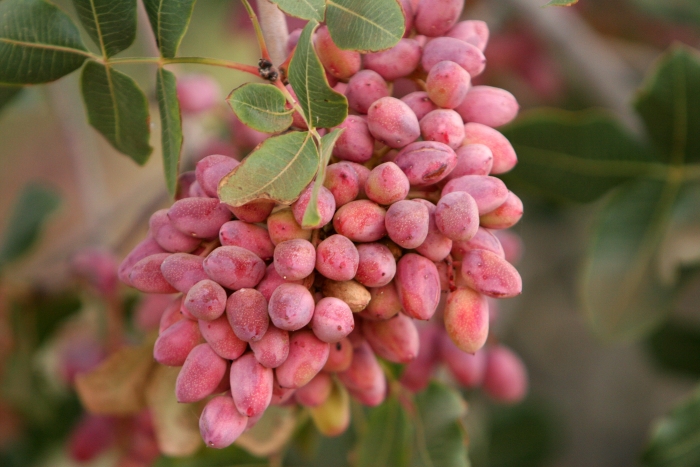Pistachio Nut
(Pistacia vera)
Pistachio Nut (Pistacia vera)
/
/

Safa.daneshvar
CC BY-SA 3.0
Image By:
Safa.daneshvar
Recorded By:
Copyright:
CC BY-SA 3.0
Copyright Notice:
Photo by: Safa.daneshvar | License Type: CC BY-SA 3.0 | License URL: https://creativecommons.org/licenses/by-sa/3.0 | Uploader: Safa.daneshvar | Publisher: Wikimedia Commons | Title: 860631-Pistachio-IMG_6862-2.jpg | Notes: User created page with UploadWizard |


































Estimated Native Range
Summary
Pistacia vera, commonly known as Pistachio Nut, is a deciduous tree native to desert regions and the high-altitude areas of Central Asia and the Middle East. It typically grows to a height of 10 meters (33 feet). The tree is characterized by its pinnate leaves and clusters of small, inconspicuous flowers, which are followed by the well-known edible seeds. The seeds, or nuts, are encased in a hard shell that splits open when ripe, revealing a mauve-colored skin and light green flesh with a distinctive flavor. Each tree can produce around 50 kilograms (110 pounds) of seeds once mature.
Pistachio trees are valued for their nuts, which are a significant agricultural crop and a popular culinary ingredient. They are also used in ornamental plantings and can provide shade in landscape designs. Pistachios require a long, hot summer for fruit ripening and a winter period cold enough to break dormancy. They are drought-tolerant and can tolerate saline soils, making them suitable for arid environments where other crops might struggle. In cultivation, they thrive in full sun and well-drained soil, with low to medium water requirements. While pistachio trees are fairly hardy, they are vulnerable to root rot in wet, poorly drained soils and do not perform well in high humidity. It is important to ensure good air circulation around the trees to prevent fungal diseases.CC BY-SA 4.0
Pistachio trees are valued for their nuts, which are a significant agricultural crop and a popular culinary ingredient. They are also used in ornamental plantings and can provide shade in landscape designs. Pistachios require a long, hot summer for fruit ripening and a winter period cold enough to break dormancy. They are drought-tolerant and can tolerate saline soils, making them suitable for arid environments where other crops might struggle. In cultivation, they thrive in full sun and well-drained soil, with low to medium water requirements. While pistachio trees are fairly hardy, they are vulnerable to root rot in wet, poorly drained soils and do not perform well in high humidity. It is important to ensure good air circulation around the trees to prevent fungal diseases.CC BY-SA 4.0
Plant Description
- Plant Type: Tree
- Height: 25-30 feet
- Width: 25-30 feet
- Growth Rate: Moderate
- Flower Color: N/A
- Flowering Season: Spring
- Leaf Retention: Deciduous
Growth Requirements
- Sun: Full Sun
- Water: Low, Medium
- Drainage: Medium, Fast
Common Uses
Bird Garden, Drought Tolerant, Edible*Disclaimer: Easyscape's listed plant edibility is for informational use. Always verify the safety and proper identification of any plant before consumption.
Natural Habitat
Desert regions and high-altitude areas of Central Asia and the Middle East
Other Names
Common Names: Pistachio, Green-Almond, Pistazie, Pistazienbaum, Echte Pistazie, Alfónsigo, Pistachero, Pistache, Pistachier, Pistachier Cultivé
Scientific Names: , Pistacia vera, Pistacia trifolia, Pistacia reticulata, Lentiscus vera, Pistacia badghysi, Pistacia macrophylla, Pistacia nemausensis, Pistacia nigricans, Pistacia officinarum
GBIF Accepted Name: Pistacia vera L.